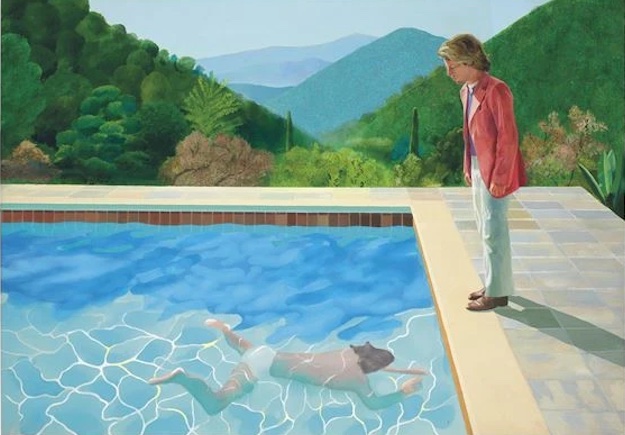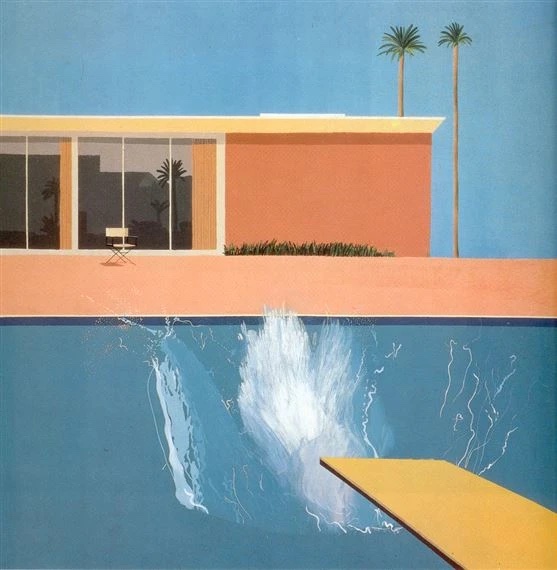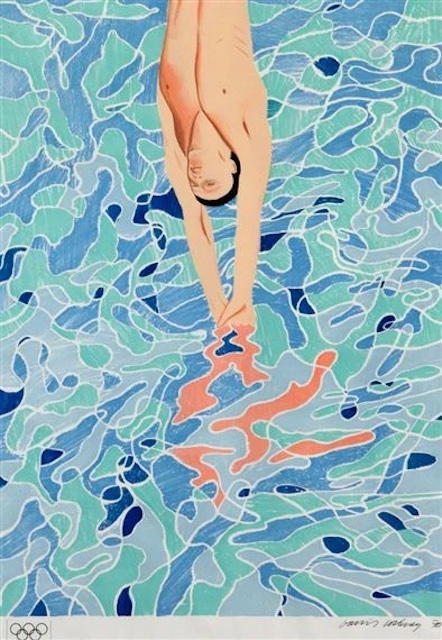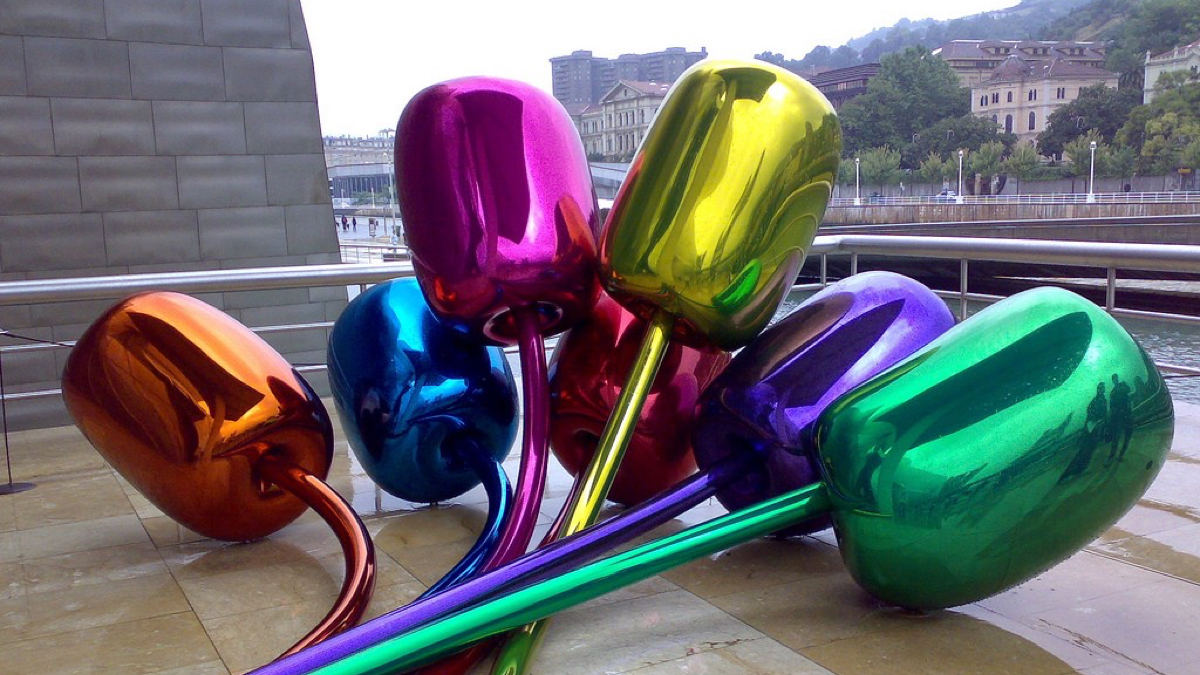
Why David Hockney's Pool Paintings Are So Popular
As Portrait of An Artist (Pool With Two Figures) stands as the most expensive painting by a living artist ever sold (sold for $90 million in 2018), we ask why exactly are David Hockney‘s pools so popular? In this article, Artsper explores the significance of the modern master’s favorite motif: the swimming pool.

Musing at first sight: a lifelong obsession with the swimming pool
It is said that David Hockney first fell in love with the humble swimming pool whilst on a flight from his native United Kingdom to Los Angeles in 1964.
Peering out of his window to see the vast urban sprawl of LA that lay beneath him, Hockney was surprised to find glimmers of color amongst the monotony of the city. He saw a mirage of aquamarine pools blinking up at him as the water reflected the white Californian daylight.
Like a magpie drawn to their shine, he also was surprised by their number. “I looked down to see blue swimming pools all over”, he told Diane Hanson in 2009. In this interview given years later, Hockney reflected on the real reason he became so fascinated in the swimming pool. They appeared to him as a socio-economic symbol of the American Dream. He said, “and I realized that a swimming pool in England would have been a luxury, whereas here they are not.” Thus, it was in this moment of voyeurism that the artist discovered a lifelong fascination with this man-made object. An object that would later come to symbolize a conversation of far greater depth in his artistic expression.
Hockney’s biography: an artist of complex character
Hockney plays into the stereotype of a humble, tortured artist. He is quoted to have said of his art, “it’s overrated. My art isn’t as good as some people think it is”. Even to this day, after achieving great financial and professional success, Hockney’s air of anti-establishment irreverence prevails. Never one for needless grandiosity in his career, so too does he communicate subtly in his artwork.
While his early works displayed traits of expressionism, similar to those of fellow artist Francis Bacon, Hockney’s career is generally viewed as having been tied to the pop-art movement. Through the practice of pop art, Hockney was able to convey complexity at the surface of his painting. This presents a rather dichotomic expression of surface-level depth in his artistic endeavours. What is meant by this is that it is in his simplistic, flat, colorful, and brash style where true depth of meaning lies. The subject matter is easily observed, but it is the understanding of its complexity where the struggle may lie.
With a paired back color palette and little attempt at creating perspective or visual depth, you would be forgiven to think that the complexity of Hockey’s paintings remains surface level. Depicting relaxed scenes of pool-goers, these paintings in fact hold greater symbolic value than Hockney’s light handling of the subject may infer at a first glance. In this essay, we shall examine why Hockney’s pools are so popular owing to their mysterious undertone.

Below the surface lies a fascination
Like any artist, Hockney’s life inspired his work. His move to Los Angeles from Great Britain in 1964 marked a great departure in his artistic expression. In the sixties, the Atlantic marked a great divide between the States and the United Kingdom. This was shown in terms of geographical difference as well as in terms of cultural change. Hockney moved from a UK in the 1960s wherein homosexuality was illegal (up until 1967). As a self-confessed “homosexual propagandist”, David Hockney found the lack of queer expression to be stifling both in terms of his personal and professional life. Los Angeles appeared like a new universe to which he was drawn by the endless possibilities of creative endeavour. Safe creative spaces for queer expression such as the Beefcake magazines of LA pulp literature symbolized the idea of coming home for Hockney.
Yet despite this greater sexual and creative freedom, Hockney’s own work remained subtle in its expression. It has to be said that Hockney somewhat enjoyed playing with the overt and introverted presentation of meaning and symbolism. It is through this liminal space of said and unsaid coding of messages, that he is perhaps able to say the most. Hockney presents juxtapositionary patterns of tension and release. Of intersections between performative and innate kitsch. Of peaks and troughs of eroticism that are so emblematic of his vision.

David Hockney’s pools of erotic, classist and queer expression
To begin to explain the fascination behind David Hockney’s pools, we must delve into the artist’s autobiography. From a working-class Northern English childhood, Hockney’s beginnings can only be described as having been humble. He would have certainly experienced a cultural shock when he went across the pond in the sixties. As a child, he would have used to local swimming baths or “lidos” in the UK. In the US, the concept of a private pool would have been foreign to him. This adoptive country presented itself as the land of the American Dream. By contrast, Hockney was a young gay artist escaping the stifling creative drought of his conservative home country. It is hard to imagine how overwhelming yet exciting this atmosphere would have appeared to a young Hockney.
Furthermore, referring back to Hockney’s interview with Diane Hanson, the pool acts as a status symbol. It’s nature as a symbol goes far beyond that indicating wealth, in fact the pool that fascinates Hockney is able to reveal far more of society.
What symbolism does water hold in David Hockney’s pools?
Water makes up the main subject matter of Hockney’s pool series. In these freeze-frame paintings, brief moments of life are captured in time. Imbued with a web of cultural connotations, Hockney seizes upon water’s symbolism of simultaneous fluidity and tension. Hockney’s American swimming pools have the appearance of sexually charged atmospheres. This is due to the cohabitation of surface and depth in the painting. This inner contrariness is the perfect metaphor for the sexual expression of a gay man in the 1960s. The transgressive act of breaking the water’s surface with a splash acts as an expression of free erotic desire. Under the thinly veiled protection of the pool water, the swimmer can appear partially covered whilst dually revealing his body in moments of transparency. In this way, a gay man can test the limits of his sexual expression while remaining within the boundaries of society.
In conclusion, it is certain that Hockney’s pools make reference to the liberal milieu in which he found himself in California in the sixties. It can be said that paintings such as Portrait of an Artist, (Pool With Two Figures) (1972) testify to an autobiographical exploration of homosexuality and friendship. David Hockney’s pools are expressive, explorative, transgressive spaces that the artist has explored throughout his almost 60-year career. It appears that a chance birds-eye glance down at those glinting pools in 1964 informed a generation of popular culture in the artistic field, and we for one, at Artsper, are so happy they did!

About Artsper
Founded in 2013, Artsper is an online marketplace for contemporary art. Partnering with 1,800 professional art galleries around the world, it makes discovering and acquiring art accessible to all.
Learn more













